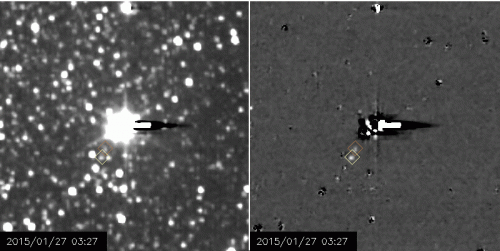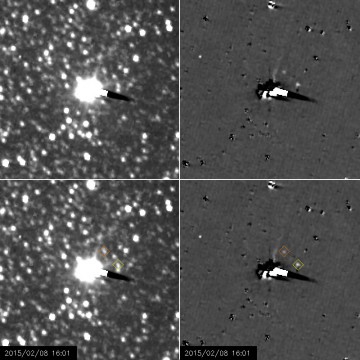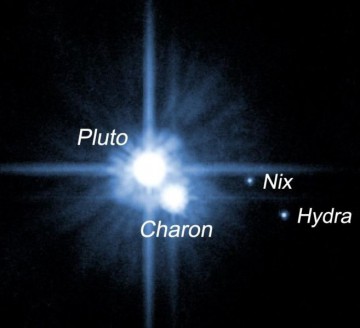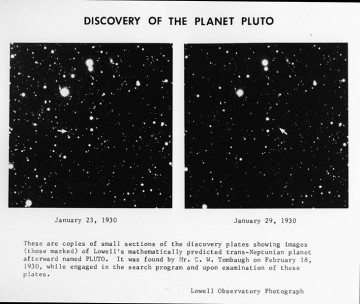
The New Horizons spacecraft, on course for a historic encounter with Pluto this summer, is now close enough to see two of its smaller moons for the first time. The new views also come 85 years after the discovery of Pluto by astronomer Clyde Tombaugh on Feb. 18, 1930.

The images were taken between Jan. 27 and Feb. 8, 2015, at distances ranging from about 125 million to 115 million miles (201 million to 186 million kilometers), and for the first time show the tiny moons Nix and Hydra, which are much smaller than Pluto’s largest moon, Charon. They are the first of a series of long-exposure images that will be taken until early March, which will allow the New Horizons team to refine the moons’ orbits ahead of the encounter on July 14.
“Professor Tombaugh’s discovery of Pluto was far ahead its time, heralding the discovery of the Kuiper Belt and a new class of planet,” said Alan Stern, the principal investigator for New Horizons from Southwest Research Institute, Boulder, Colo. “The New Horizons team salutes his historic accomplishment.”
As New Horizons science team member John Spencer, also from Southwest Research Institute, noted: “It’s thrilling to watch the details of the Pluto system emerge as we close the distance to the spacecraft’s July 14 encounter. This first good view of Nix and Hydra marks another major milestone, and a perfect way to celebrate the anniversary of Pluto’s discovery.”

In the right-hand versions of the images, the glare from Pluto, Charon, and background stars has been mostly removed in order to see Nix and Hydra more clearly. The blotchy and streaky features are not real, just artifacts of the image processing.
The images were also assembled into a seven-frame movie, showing Nix and Hydra moving in their orbits around Pluto. Each frame is a combination of five 10-second images, taken with the Long-Range Reconnaissance Imager (LORRI) instrument on New Horizons.
Nix and Hydra were first discovered in images taken by the Hubble Space Telescope in 2005. Hydra is the outermost known moon of Pluto, and orbits every 38 days at a distance of 40,200 miles (64,700 kilometers). Nix orbits every 25 days at a distance of 30,260 miles (48,700 kilometers). Both moons are tiny, between 25-95 miles (40-150 kilometers) in diameter, but more accurate measurements won’t be possible until New Horizons gets closer.
There are at least two other moons, Styx and Kerberos, which are even smaller and too faint still to be seen by New Horizons at this distance.

Since Pluto is so small itself, being classified as a dwarf planet, it was a surprise to find that it has at least five moons orbiting it. There may even be others, still as yet undetected. Even Mars, which is much larger than Pluto, only has two tiny asteroid-sized moons, Phobos and Deimos. And Earth, of course, has only one moon. Venus and Mercury have none.
Some astronomers think that Pluto may also have faint rings, but this won’t be able to be confirmed, or refuted, until New Horizons gets much closer this summer. It is also possible that Pluto and Charon uniquely share the same atmosphere, as tenuous as it is. That atmosphere may sublimate and condense between the two bodies in an ever-repeating cycle depending on the season and amount of sunlight. It is even thought that Pluto or Charon may have an interior ocean of water, or at least used to, similar to Europa or Enceladus. Even with the little that is known to date, astronomers are certain that Pluto and its moons are more active and intriguing than used to be thought possible.
New Horizons had also recently sent back its best images of Pluto so far, the first of many to come as the spacecraft approaches the dwarf planet. They will continue to only get better from now on, and soon they will surpass the best images taken by the Hubble Space Telescope. In those images, Pluto and its moons look like little more than bright dots of light. Faint features can just be seen on Pluto’s surface, but nothing more.
That will all change this summer, however, when New Horizons conducts the first-ever flyby of this remote and fascinating little world. That tiny point of light will finally become a real place, never before seen up close until now.
Want to keep up-to-date with all things space? Be sure to “Like” AmericaSpace on Facebook and follow us on Twitter: @AmericaSpace
Missions » New Horizons »



One Comment
One Ping
Pingback:Getting closer! New Horizons sees two of Pluto's smaller moons for first time